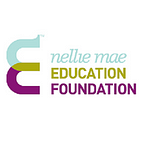Strategy Update: October 2019
At the Nellie Mae Education Foundation, 2019 has been a year of designing a strategy aligned to the Foundation’s new mission, vision, values, and goals towards racial equity. We can also say that 2019 has been a year of reflecting, learning, growing, and transforming for us.
Through our strategy review and development process, we have been committed to sharing updates about our journey. Last month, Nellie Mae’s staff, along with a few of our Community Advisors, met with our Board of Directors for our September meeting.
We are proud to announce that our Board affirmed the direction of our proposed grantmaking strategy, which is slated to commence in the first quarter of 2020. We do not plan on adopting a five or ten year grantmaking strategy — rather, we anticipate a new grantmaking approach that calls for deepening relationships with grantees, continuously learning, and adapting over time. We anticipate a formal Board adoption of the strategy at our December Board of Directors meeting.
As we have mentioned before, our new grantmaking strategy will be focused on meeting three goals:
1. Community, education and teacher leaders, and their organizations are supported to advance change efforts at the local and state level that prioritize racial equity outcomes;
2. Sustained authentic partnerships between communities and their schools are identifying and implementing solutions to achieve racially equitable outcomes; and
3. Local, state, and national alliances and partnerships are effectively focused on dismantling and transforming systemic (structural and institutional) barriers to racial equity within the educational ecosystem.
More concretely, our grantmaking will focus on a core initiative aimed at achieving the goals above and advancing our mission of championing efforts that prioritize community goals that challenge racial inequities and advance excellent, student-centered public education for all New England youth. Our primary work will center on A). Building the capacity and leadership of BIPOC (Black, Indigenous, and People of Color)-led and BIPOC-serving community organizations; B). Supporting youth organizing groups who are working to advance racial equity in public education; and C). Supporting community-led and informed collaborative work between local school systems and their communities, with an emphasis on challenges and solutions related to racial equity.
Along the way, we will support our grantees to build relationships with each other through a network approach. Work through state and local partnerships in support of community goals will grow as we identify our grantee partners, examine their interests more closely, and consult with them about how these broader coalitions can and should be organized.
Additionally, we have begun organizing work to examine student-centered learning through a racial equity lens — examining how our current frame impedes learning and opportunities for people of color.
Each of these areas of work will be structured to reinforce and inform each other, with the goal of reaching our vision of all youth having access to equitable, public education that prepares them to succeed and thrive in community.
We recognize that though much of this work is new to us, it is not new to the field. Individuals, organizations, and funders have been committed to racial equity work for years, and we have much to learn from the path they have shepherded. Additionally, we recognize that those most affected by racial inequities in our education system are often left out of decision-making processes.
We aspire to show up in ways that support community-driven efforts to strengthen the field of education, elevate conversations of racial inequity, and influence how decisions are made. It is our privilege and honor to be contributors to this work.
And we know that in order to engage in this work authentically and effectively, we must continue to examine our own practices and culture. More specifically, this means rigorously and honestly understanding how dominant white culture shows up in our organization, and how we might shift that culture towards a more racially equitable one.
It is also important to note that while we are exercising transparency in sharing where we are, the areas of focus we have just named are still under development and are not yet finalized. Moreover, details are still being worked out, including a timeline, regional focus within New England, and eligibility for grantmaking. In the meantime, we are continuing to learn about the landscape of communities doing racial equity work throughout the region, and welcome you to tell us about the work that your organization is doing.
In partnership,
The Nellie Mae Education Foundation
